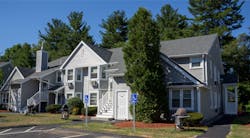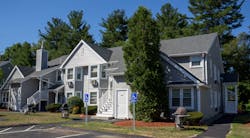Condensing Gas Boilers at Home at Massachusetts Apartment Complex
At the Riverview Meadows apartment complex in Raynham, Mass., each of 10 20-plus-year-old buildings—each containing eight apartment homes—was heated with a 400,000-Btu cast-iron, floor-standing boiler.
“The old unit was non-condensing and non-modulating, which meant it was on or off—it was full speed ahead, or it was idle,” Tim O’Brien of David Gooding Inc., Brockton, Mass.-based manufacturers’ representative of plumbing, heating, and waterworks products, said. “No matter what the heat loss and heat requirements were—even if it was just for 20,000 Btus—that old dinosaur unit still fired up to 400,000 Btus immediately and wasted a lot of fuel.”
“The cascading and common venting of Navien units is a huge advantage over some of the competition,” O’Brien said. “Cascading means that these units are talking to one another and providing proper inputs and balanced run time. One unit will come on for a load, run up to about 80 percent of its capacity, and then it will activate the other unit to meet the heat-load requirement with full system modulation. The benefit of lead/lag, alternate sequential firing the next time that cycle is initiated is near equal run times. At the end of 10 or 20 years, you have approximately the same amount of run time on each unit. Along with that, common venting allows us to tie the exhausts together and the intakes together, minimizing the amount of venting that is needed for each project and the amount of perforations in each building. In this case, we have the intake drawing through a plenum on the side of the building, eliminating the chance of the exhaust contaminating the intake.”
The balanced production from each unit provides a longer lifespan and lower chance of failure in each unit. Should one of the units experience a failure or downtime, the multiple-unit cascaded system offers a significant solution to make sure not all is lost.
“A huge benefit of the multiboiler cascaded system is the built-in redundancy,” O’Brien said. “If there should be planned service or failure in either unit, the other unit will still be able to operate and hopefully keep the building warm until the contractor can service the non-operable unit. That is a situation that you would not have with the floor-standing unit or any single unit. A failure with the old unit and you could have a freezing building or tenants that can’t take a hot shower.”
Tested according to U.S. Department of Energy procedures, NHB units have an efficiency rating of 95 percent. The NHB-150s at Riverview Meadows have a turndown ratio of 15:1, which allows them to produce only the level of output needed at a given time, saving a considerable amount of energy compared with the old cast-iron units. Along with a high efficiency rating, each Navien NHB unit came with a 10-year warranty on the heat exchanger, providing peace of mind to the owners, who are confident they will have intelligent and efficient boiler operation for years to come.


